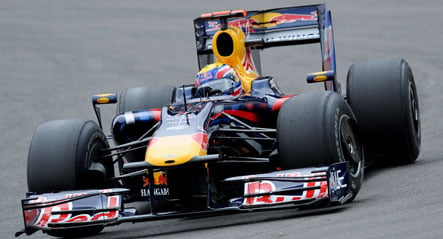The 32-year-old Red Bull driver made the most of changeable weather conditions at the Nürburgring to emerge in front with a best lap of one minute and 32.230 seconds. This lifted him clear of Brazilian Rubens Barrichello of Brawn GP, who was second fastest, as dry weather followed a rain-hit session.
Championship leading Briton Jenson Button, in the second Brawn, was third fastest ahead of German Sebastian Vettel in the second Red Bull.
“Great, thank-you guys – awesome!” said Webber on his slowing down lap after being told that after 128 races he had topped the times to take the prime starting position for a Grand Prix.
Defending world champion Briton Lewis Hamilton was fifth for McLaren-Mercedes, proving that his team’s efforts to improve their car were working at last after a series of desperately-disappointing performances.
His team-mate Finn Heikki Kovalainen was sixth ahead of German Adrian Sutil of Force India, in their first top ten position, Brazilian Felipe Massa and his Ferrari team-mate Finn Kimi Raikkonen with Brazilian Nelson Piquet 10th for Renault.
After an early foray by Button, who was first out on track without clocking a time, the top ten cars delayed until the final three minutes before attacking the clock to deliver their best laps. Barrichello was first to take top spot, but was soon overtaken by Hamilton in the final dramas.
On another cool, overcast and sometimes wet day, Vettel was the first man out of the pit lane at the start of the session run in front of a big crowd of German fans congregated in the Eifel mountains. The young German’s appearance heralded a rush of lap times from everyone, the weather clearly persuading all the teams that it was necessary to clock a fast early time before any heavy rain fell.
The Red Bulls made the most of the brief respite from wet conditions when Vettel went top and he was soon followed by team-mate Webber before the skies opened and the session was, effectively, curtailed.
Webber ended Q1, the first mini-session, on top ahead of Alonso with Vettel third and Hamilton fourth in the resurgent McLaren, but it was ‘goodbye’ for the bottom five.
That meant the exit of Pole Robert Kubica of BMW Sauber, Swiss Sebastien Buemi of Toro Rosso, Italian Giancarlo Fisichella of Force India, German Timo Glock of Toyota and Frenchman Sebastien Bourdais in the second Toro Rosso.
It was particularly bad news for the French driver who, according to the paddock rumour machine, was preparing for his last race with the team before being replaced. But it was disappointing also for the crowd to see Glock departing – one of five Germans in the 20-car field – and the BMW-powered car of Kubica failing to deliver a competitive performance.
When Q2 began, the steady drizzle and the wet track conditions caught several drivers out as they slithered around on their slick tyres. Japanese Kazuki Nakajima in his Williams slid off the track, Hamilton brushed a kerb and Massa ran wide and off the track across grass.
The conditions meant that everyone was struggling to clock times that would carry through to the top-ten shootout with lap times increasing by 11 seconds. The field dived into the pits for intermediate tyres.
With six minutes remaining, Barrichello chose to switch back to dry tyres and went out and clocked the fastest lap by almost four seconds – making the most of a brief dry window before rain returned.
These capricious conditions caught several drivers and teams out when the rain returned and in the panic in the pit-lane Vettel managed to collide with Nakajima, both cars emerging without serious damage.
Button, with a late lap, just squeezed through into the top ten with Hamilton as both Alonso and Raikkonen slipped off the slippery surface. In the end, the rain claimed the hopes of German Nick Heidfeld in his BMW, Alonso, fuming as he stepped out of his Renault, Nakajima, Italian Jarno Trulli of Toyota and German Nico rosberg of Williams.
Kovalainen, with some heart-stopping survival moves, squeezed into the top ten, his performance proving that McLaren’s improvement this weekend is genuine – while Sutil took a Force India into the top ten for the first time and Nelson Piquet out-qualified his team-mate Alonso for the first time.
No wonder the Spaniard was so frustrated. As he surveyed the scene, the rain departed as quickly as it came and the track began to dry out again for the final Q3 session.



 Please whitelist us to continue reading.
Please whitelist us to continue reading.
Member comments